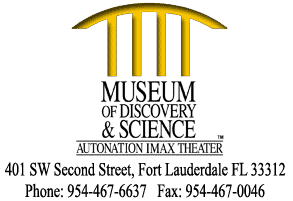Birds of Paradise: Amazing Avian Evolution
Now Open through September 4 2017
"'Survival of the sexiest': Birds strut their stuff in National Geographic exhibition" - Sun Sentinel Review of the exhibit |
Enter to win a FREE Manatee (Family) Membership.
Take our Birds of Paradise Trivia Quiz by CLICKING HERE
|
This stunning exhibit developed by National Geographic and The Cornell Lab of Ornithology captures all 39 known species ofbirds-of-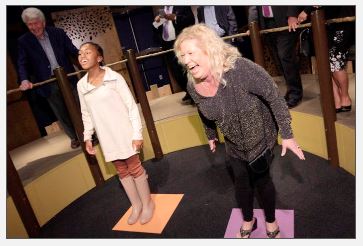 paradise.
In 2004, National Geographic photographer Tim Laman and Cornell University Lab of Ornithology scientist Edwin Scholes began a series of 18 targeted expeditions to document these bizarre birds. More than a decade and 37 distinct geographic locations later, they are on the verge of completing the first comprehensive study of all 39 known species of birds of paradise. Coverage includes photographs of all varieties and several never-before documented behaviors and interactions. paradise.
In 2004, National Geographic photographer Tim Laman and Cornell University Lab of Ornithology scientist Edwin Scholes began a series of 18 targeted expeditions to document these bizarre birds. More than a decade and 37 distinct geographic locations later, they are on the verge of completing the first comprehensive study of all 39 known species of birds of paradise. Coverage includes photographs of all varieties and several never-before documented behaviors and interactions.
The fascinating stories of groundbreaking research and adventure paired with amazing footage and photography are the foundation of this highly interactive exhibition.“Birds of Paradise” is a story of daring expeditions, world culture, extreme evolution, and conservation, as only National Geographic can present, with stunning imagery, compelling video, soundscapes, artifacts, and engaging educational activities for all ages.
“Birds of Paradise” is a science exhibition, art show, and natural history display all rolled into one exhibit that encompasses sounds bites, videos, photographs and artifacts from their expeditions. The hands-on, multi-media components and mechanical and digital mini-stations allow students to better understand how these beautiful creatures have influenced a conservation movement.
Ground Dancing
Use your best dance moves to mimic the elaborate courtship dances of the birds-of-paradise! “Dance Dance Evolution” uses motion-capture technology to turn you into a male Parotia. Try the “ballerina dance” and “hop-and-waggle” as your friends play the female Parotia, voting on your performance.
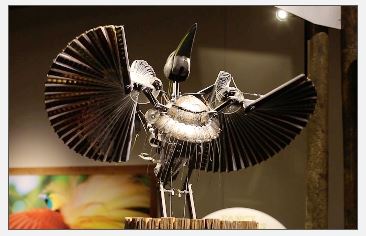
Shapeshifting
From peculiar postures to outlandish ornamental feathers, the birds-of-paradise are masters of transformation. See the remarkable ability of these male birds to transform themselves in attempts to impress the females – from the kinetic sculpture of a riflebird opening its wings, to a frame-by-frame step-through of the 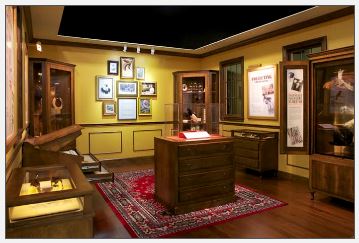 superb bird-of-paradise’s dance. superb bird-of-paradise’s dance.
The Victorian Study
Introduced to Europe by Magellan’s fleet in 1521, the birds-of-paradise have attracted the interest of illustrators, naturalists, collectors, and the wealthy and fashionable. Learn about early misconceptions and the feather trade, see period bird specimens and illustrations, and discover the work of famed naturalist Alfred Russel Wallace.
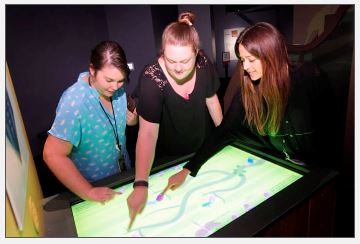
Modern Science
Tim Laman and Ed Scholes’ expeditions are part of the latest chapter of scientific inquiry into the birds-of-paradise. See how their extensive photos and video are the contemporary analog to the Victorians’ physical specimens, and explore the evolutionary mechanism of sexual selection by playing the part of a bird in a touch-table interactive.
The 39 Species
The 39 species of birds-of-paradise include tiny, starling-sized birds and big, crow-sized birds; birds in vivid blues, greens, and reds; birds with head plumes, tail plumes, back plumes, chest plumes, and no plumes; mountain birds and swamp birds; branch dancers, pole dancers, ballerina dancers. The Birds-of-Paradise Project is the first to capture all 39 in stills and video. Catch a glimpse of every one of them here. CLICK HERE to learn more.
EXHIBIT SPONSORS
“Birds of Paradise” is a science exhibition, art show, and natural history display all rolled into one exhibit that encompasses sounds bites, videos, photographs and artifacts from their expeditions. The hands-on, multi-media components and mechanical and digital mini-stations allow students to better understand how these beautiful creatures have influenced a conservation movement.
|
| ADDITIONAL RESOURCES |
Introduction To Birds of Paradise Project
It took 8 years and 18 expeditions to New Guinea, Australia, and nearby islands, but Cornell Lab scientist Ed Scholes and National Geographic photographer Tim Laman succeeded in capturing images of all 39 species in the bird-of-paradise family for the first time ever.
This video gives a sense of their monumental undertaking and the spectacular footage that resulted.
CLICK HERE to Learn More |
CLICK HERE for more information at the National Geographic Society, co-sponsor of the exhibit
CLICK HERE for more information about the Cornell Lab of Ornithology, co-sponsor of the exhibit
CHECK OUT the www.allaboutbirds.org website to learn about birds more generally
EDUCATORS - CLICK HERE for the educator website
CLICK HERE to download the Educator Guide (PDF file format)
CLICK HERE to download the Student Guide(PDF file format)
CLICK HERE to Download the "Voices of Birds-of-Paradise" Audio Guide.
They may be known for their variety of appearance, but the birds-of-paradise are equally impressive for the diversity of their sounds. |
Ed Scholes Evolutionary Biologist -
Birds of Paradise Project
How do you get to be an evolutionary biologist who does fieldwork in remote tropical forests? As Ed explains, he was a pretty normal kid from the suburbs. A high-school teacher took him out on class field trips, and Ed realized that being a scientist could mean going on field trips as a career. After seeing an early TV show about birds-of-paradise, he knew where he wanted to go.
CLICK HERE to Learn More
|
Tim Laman Wildlife Photojournalist -
Birds of Paradise Project
Tim Laman is both a trained biologist and one of the foremost nature photographers in the world. As he explains in this video, he achieved this not by following a set path but by using all his energy, passion, and creativity to pursue the things that captivated his interests.
CLICK HERE to Learn More
|
|

